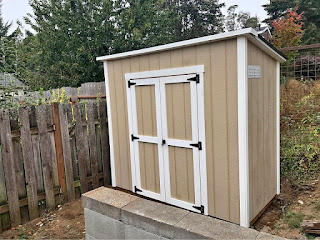A lean to shed is a simple yet practical storage solution for your backyard. Not only does it provide extra storage space for your outdoor tools and equipment, but it can also be an attractive addition to your property. In this article, we will share some lean to shed design ideas that can help you maximize functionality and aesthetics.
1. Consider the Purpose
Before diving into the design process, it's important to consider the purpose of your lean to shed. Do you need a space to store your gardening tools, a workshop for your DIY projects, or a place to park your outdoor equipment? The purpose will determine the size and layout of your shed, as well as the materials and features you'll need.
2. Choose the Right Location
The location of your lean to shed is crucial. It should be easily accessible and situated in an area that is level and dry. Consider the sun exposure and wind direction as well, as these factors can affect the durability and comfort of your shed. Ideally, the shed should be close to the main house or garage for easy access.
3. Select the Right Materials
The
materials you choose for your lean to shed can affect its durability and appearance. Some popular options include wood, metal, and vinyl. Wood is a classic choice that offers a rustic and natural look, but it requires regular maintenance to prevent rot and decay. Metal sheds are sturdy and low-maintenance, but they may not offer the same aesthetic appeal as wood. Vinyl sheds are durable and attractive, but they can be more expensive than other options.
4. Determine the Size and Layout
The size and layout of your lean to shed will depend on your specific needs and the available space. Consider the height, width, and depth of the shed, as well as the door and window placement. Make sure to leave enough space for ventilation and insulation if needed.
5. Add Functional Features
To maximize the functionality of your lean to shed, consider adding some functional features. Shelves, pegboards, and hooks can help you organize your tools and equipment. If you're using the shed as a workshop, consider adding a workbench and adequate lighting. A ramp can make it easier to move heavy equipment in and out of the shed.
6. Incorporate Aesthetics
While functionality is important, it's also important to consider the aesthetics of your lean to shed. A well-designed shed can enhance the overall look of your backyard and increase your home's curb appeal. Consider adding a coat of paint or stain in a complementary color to your home's exterior. You can also add decorative elements like window boxes or shutters.
7. Get Creative
Finally, don't be afraid to get creative with your lean to shed design. There are countless ways to personalize your shed and make it truly unique. Consider adding a porch or overhang for added protection from the elements. You can also incorporate recycled materials or repurpose old items for a truly one-of-a-kind look.
Conclusion
In conclusion, a well-designed lean to shed can provide both functionality and aesthetics to your backyard. By considering the purpose, location, materials, size and layout, functional features, aesthetics, and creativity, you can create a shed that meets your specific needs and enhances the overall look of your property. With these lean to shed design ideas, you're sure to find inspiration for your own backyard storage solution.




